Strategic Analysis of Sainsbury's Business Context and Management
VerifiedAdded on 2023/06/14
|10
|3362
|85
Report
AI Summary
This report provides an in-depth analysis of Sainsbury's business context, examining both internal and external factors that influence managerial decisions. Using tools like Porter's Five Forces and VRIO analysis, the report assesses Sainsbury's competitive environment, market position, and strategic advantages. It addresses the impact of COVID-19 on the business, evaluates the company's market size using the TAM model, and discusses the influence of organizational change and culture. The analysis also covers Sainsbury's marketing strategies, operational management using Six Sigma, and strategic planning with the PDCA tool, ultimately aiming to provide insights into how Sainsbury's can achieve sustainable growth and improve its profitability while maintaining an eco-friendly approach.
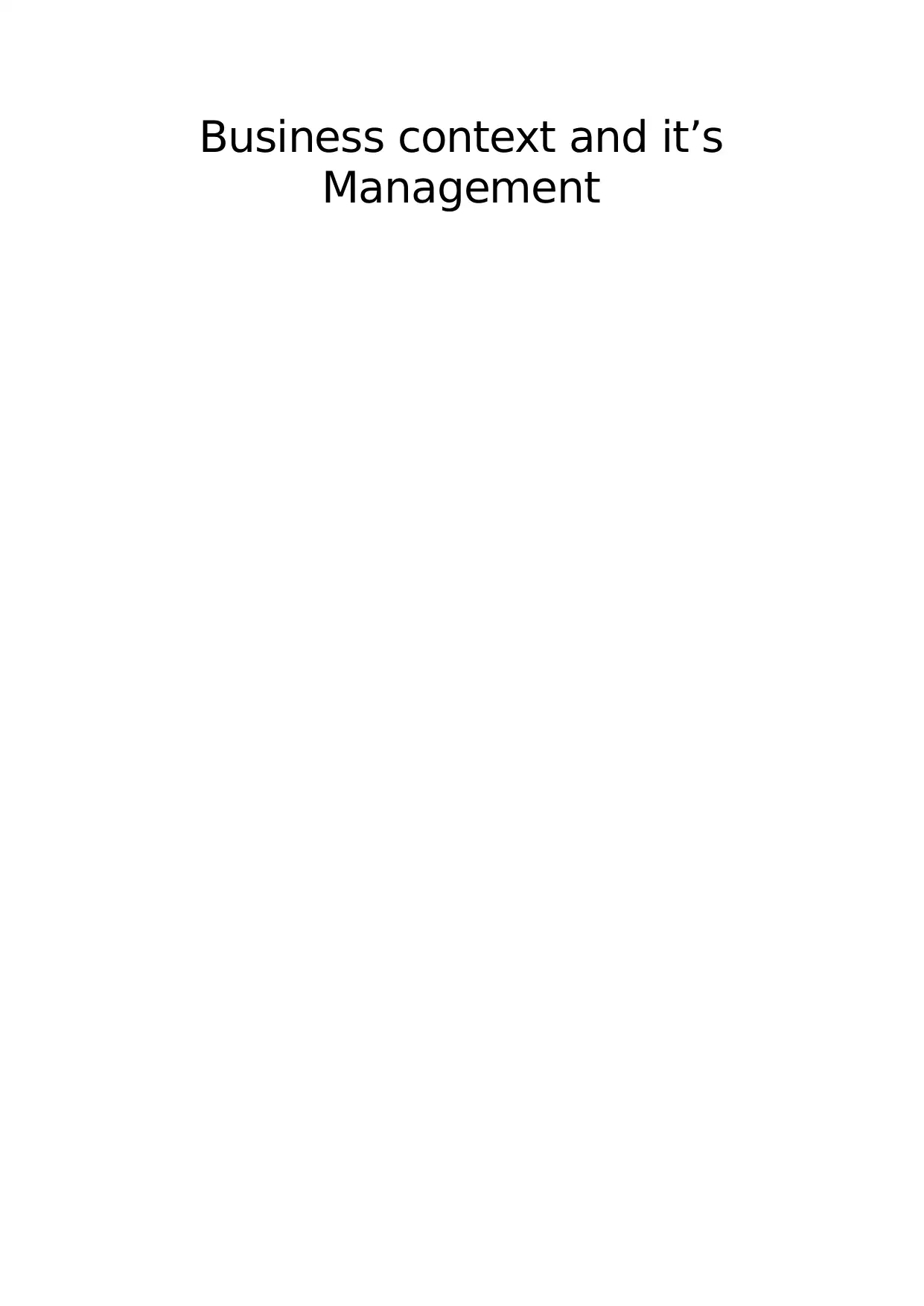
Business context and it’s
Management
Management
Paraphrase This Document
Need a fresh take? Get an instant paraphrase of this document with our AI Paraphraser
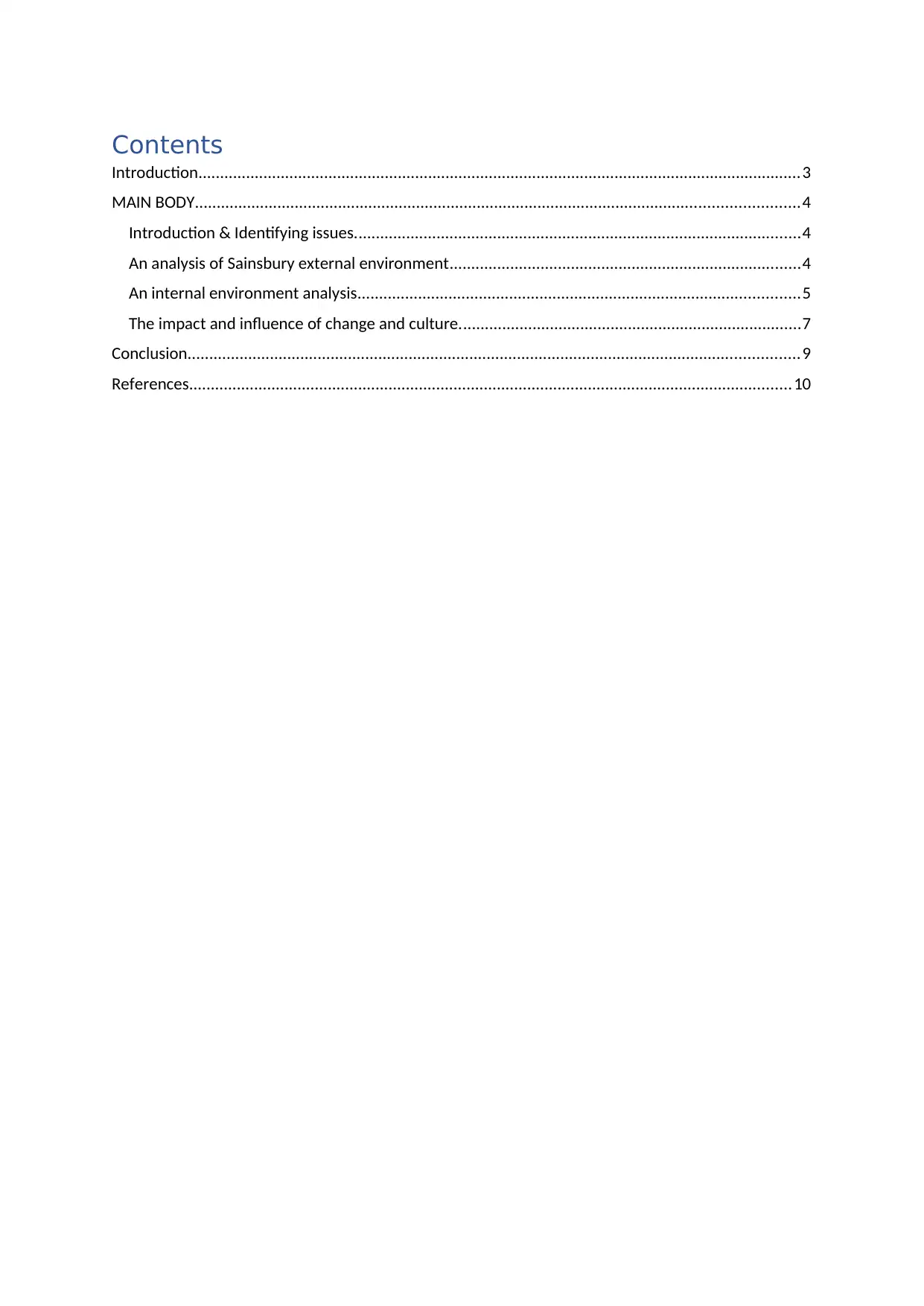
Contents
Introduction...........................................................................................................................................3
MAIN BODY...........................................................................................................................................4
Introduction & Identifying issues.......................................................................................................4
An analysis of Sainsbury external environment.................................................................................4
An internal environment analysis......................................................................................................5
The impact and influence of change and culture...............................................................................7
Conclusion.............................................................................................................................................9
References...........................................................................................................................................10
Introduction...........................................................................................................................................3
MAIN BODY...........................................................................................................................................4
Introduction & Identifying issues.......................................................................................................4
An analysis of Sainsbury external environment.................................................................................4
An internal environment analysis......................................................................................................5
The impact and influence of change and culture...............................................................................7
Conclusion.............................................................................................................................................9
References...........................................................................................................................................10

Introduction
This report involves the Sainsbury internal and external factors of the organization as internal
factors are the vrio and external factor analyzation is porters 5 force. It involves the
analyzation of business context and their influence on managerial decisions. It includes the
various analytical tools and models which helps in organizational analyzation for the better
strategic planning and better results to those strategies. It also involves the various
management practices which are challenging to the business context and the recommended
strategies that can be used to resolve that and can get better results from that. It also includes
the market size with TAM model and how had covid impacted the business and now can be
sustainable for the long run. The analyzation is described below.
This report involves the Sainsbury internal and external factors of the organization as internal
factors are the vrio and external factor analyzation is porters 5 force. It involves the
analyzation of business context and their influence on managerial decisions. It includes the
various analytical tools and models which helps in organizational analyzation for the better
strategic planning and better results to those strategies. It also involves the various
management practices which are challenging to the business context and the recommended
strategies that can be used to resolve that and can get better results from that. It also includes
the market size with TAM model and how had covid impacted the business and now can be
sustainable for the long run. The analyzation is described below.
⊘ This is a preview!⊘
Do you want full access?
Subscribe today to unlock all pages.

Trusted by 1+ million students worldwide
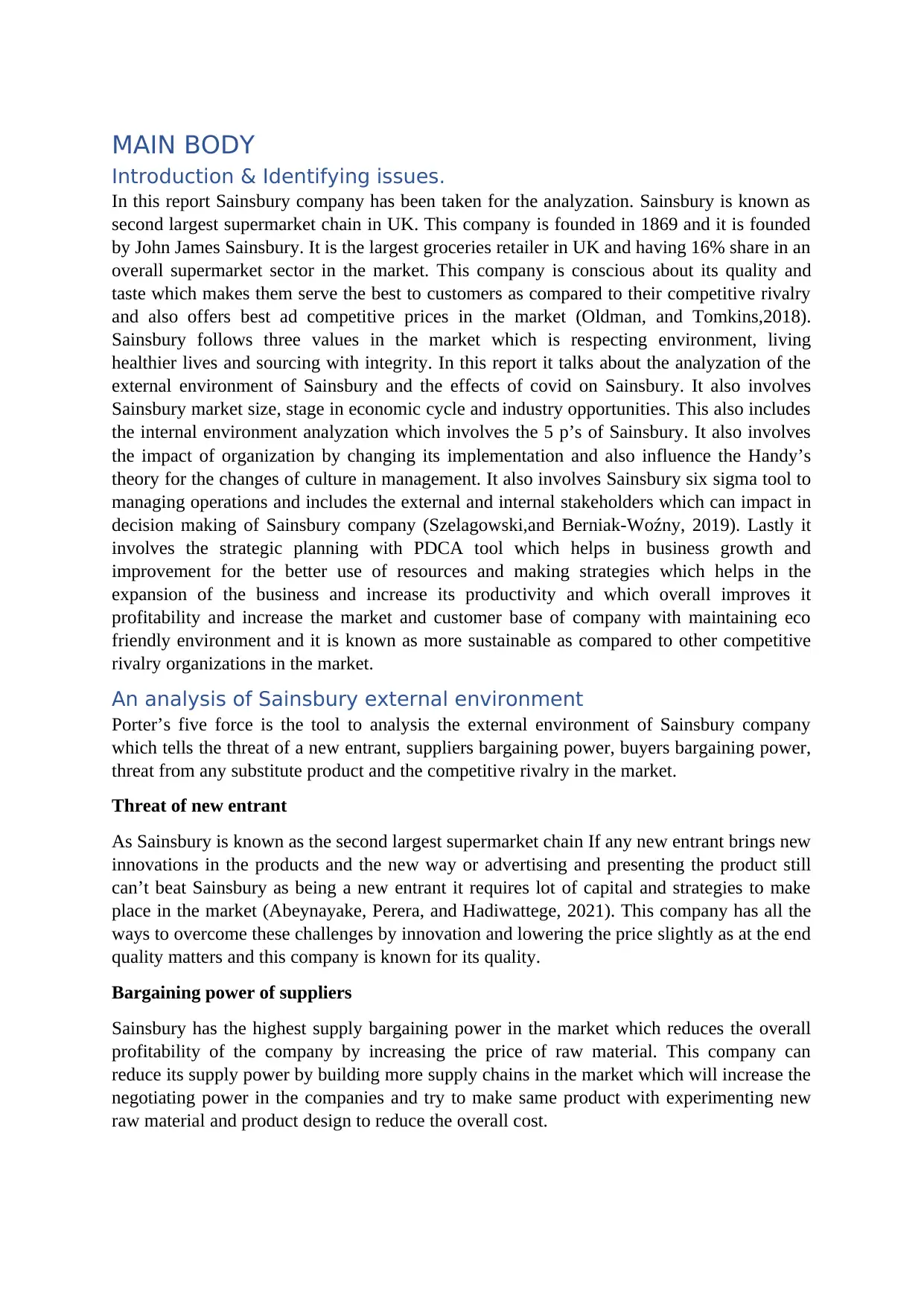
MAIN BODY
Introduction & Identifying issues.
In this report Sainsbury company has been taken for the analyzation. Sainsbury is known as
second largest supermarket chain in UK. This company is founded in 1869 and it is founded
by John James Sainsbury. It is the largest groceries retailer in UK and having 16% share in an
overall supermarket sector in the market. This company is conscious about its quality and
taste which makes them serve the best to customers as compared to their competitive rivalry
and also offers best ad competitive prices in the market (Oldman, and Tomkins,2018).
Sainsbury follows three values in the market which is respecting environment, living
healthier lives and sourcing with integrity. In this report it talks about the analyzation of the
external environment of Sainsbury and the effects of covid on Sainsbury. It also involves
Sainsbury market size, stage in economic cycle and industry opportunities. This also includes
the internal environment analyzation which involves the 5 p’s of Sainsbury. It also involves
the impact of organization by changing its implementation and also influence the Handy’s
theory for the changes of culture in management. It also involves Sainsbury six sigma tool to
managing operations and includes the external and internal stakeholders which can impact in
decision making of Sainsbury company (Szelagowski,and Berniak-Woźny, 2019). Lastly it
involves the strategic planning with PDCA tool which helps in business growth and
improvement for the better use of resources and making strategies which helps in the
expansion of the business and increase its productivity and which overall improves it
profitability and increase the market and customer base of company with maintaining eco
friendly environment and it is known as more sustainable as compared to other competitive
rivalry organizations in the market.
An analysis of Sainsbury external environment
Porter’s five force is the tool to analysis the external environment of Sainsbury company
which tells the threat of a new entrant, suppliers bargaining power, buyers bargaining power,
threat from any substitute product and the competitive rivalry in the market.
Threat of new entrant
As Sainsbury is known as the second largest supermarket chain If any new entrant brings new
innovations in the products and the new way or advertising and presenting the product still
can’t beat Sainsbury as being a new entrant it requires lot of capital and strategies to make
place in the market (Abeynayake, Perera, and Hadiwattege, 2021). This company has all the
ways to overcome these challenges by innovation and lowering the price slightly as at the end
quality matters and this company is known for its quality.
Bargaining power of suppliers
Sainsbury has the highest supply bargaining power in the market which reduces the overall
profitability of the company by increasing the price of raw material. This company can
reduce its supply power by building more supply chains in the market which will increase the
negotiating power in the companies and try to make same product with experimenting new
raw material and product design to reduce the overall cost.
Introduction & Identifying issues.
In this report Sainsbury company has been taken for the analyzation. Sainsbury is known as
second largest supermarket chain in UK. This company is founded in 1869 and it is founded
by John James Sainsbury. It is the largest groceries retailer in UK and having 16% share in an
overall supermarket sector in the market. This company is conscious about its quality and
taste which makes them serve the best to customers as compared to their competitive rivalry
and also offers best ad competitive prices in the market (Oldman, and Tomkins,2018).
Sainsbury follows three values in the market which is respecting environment, living
healthier lives and sourcing with integrity. In this report it talks about the analyzation of the
external environment of Sainsbury and the effects of covid on Sainsbury. It also involves
Sainsbury market size, stage in economic cycle and industry opportunities. This also includes
the internal environment analyzation which involves the 5 p’s of Sainsbury. It also involves
the impact of organization by changing its implementation and also influence the Handy’s
theory for the changes of culture in management. It also involves Sainsbury six sigma tool to
managing operations and includes the external and internal stakeholders which can impact in
decision making of Sainsbury company (Szelagowski,and Berniak-Woźny, 2019). Lastly it
involves the strategic planning with PDCA tool which helps in business growth and
improvement for the better use of resources and making strategies which helps in the
expansion of the business and increase its productivity and which overall improves it
profitability and increase the market and customer base of company with maintaining eco
friendly environment and it is known as more sustainable as compared to other competitive
rivalry organizations in the market.
An analysis of Sainsbury external environment
Porter’s five force is the tool to analysis the external environment of Sainsbury company
which tells the threat of a new entrant, suppliers bargaining power, buyers bargaining power,
threat from any substitute product and the competitive rivalry in the market.
Threat of new entrant
As Sainsbury is known as the second largest supermarket chain If any new entrant brings new
innovations in the products and the new way or advertising and presenting the product still
can’t beat Sainsbury as being a new entrant it requires lot of capital and strategies to make
place in the market (Abeynayake, Perera, and Hadiwattege, 2021). This company has all the
ways to overcome these challenges by innovation and lowering the price slightly as at the end
quality matters and this company is known for its quality.
Bargaining power of suppliers
Sainsbury has the highest supply bargaining power in the market which reduces the overall
profitability of the company by increasing the price of raw material. This company can
reduce its supply power by building more supply chains in the market which will increase the
negotiating power in the companies and try to make same product with experimenting new
raw material and product design to reduce the overall cost.
Paraphrase This Document
Need a fresh take? Get an instant paraphrase of this document with our AI Paraphraser
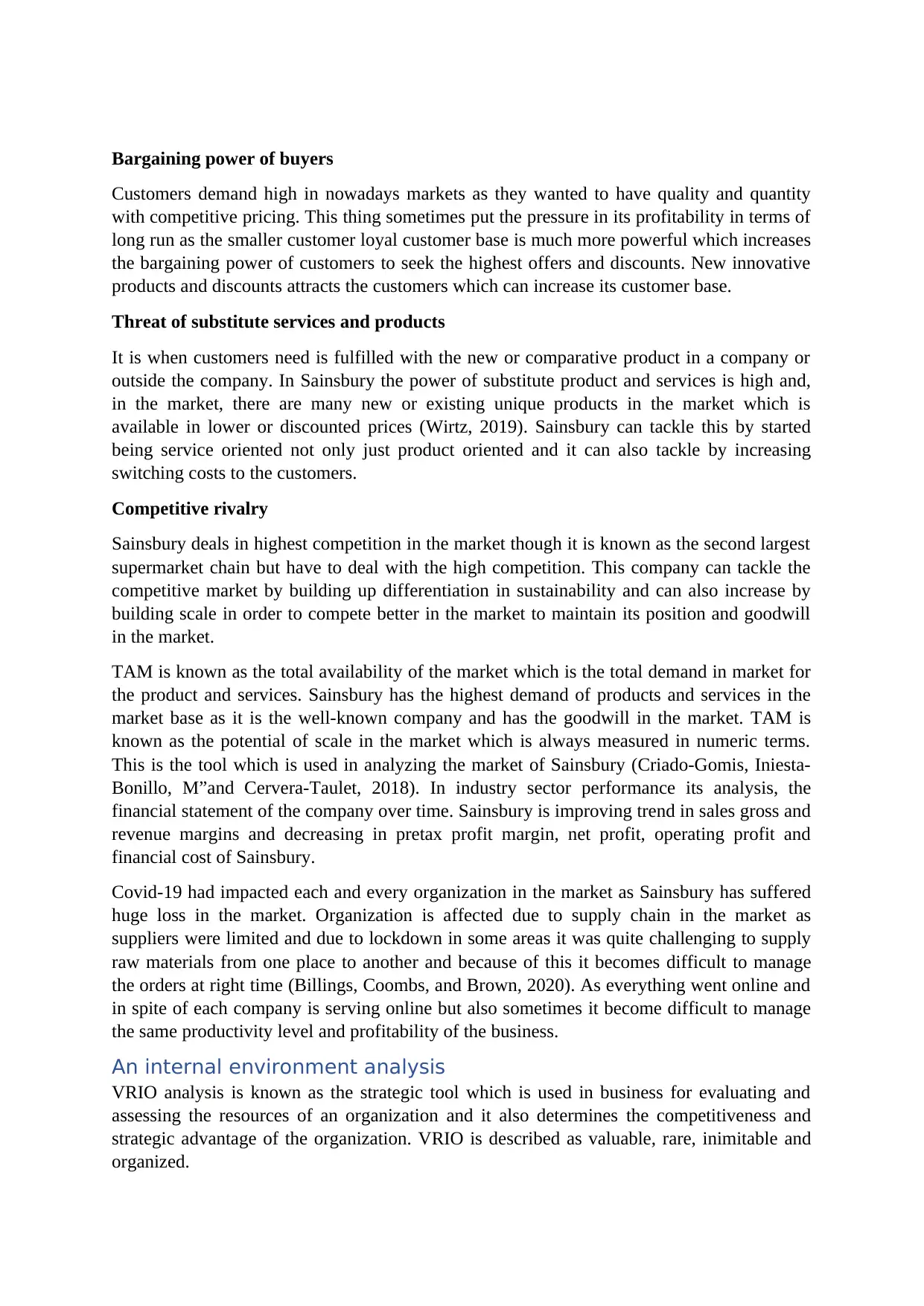
Bargaining power of buyers
Customers demand high in nowadays markets as they wanted to have quality and quantity
with competitive pricing. This thing sometimes put the pressure in its profitability in terms of
long run as the smaller customer loyal customer base is much more powerful which increases
the bargaining power of customers to seek the highest offers and discounts. New innovative
products and discounts attracts the customers which can increase its customer base.
Threat of substitute services and products
It is when customers need is fulfilled with the new or comparative product in a company or
outside the company. In Sainsbury the power of substitute product and services is high and,
in the market, there are many new or existing unique products in the market which is
available in lower or discounted prices (Wirtz, 2019). Sainsbury can tackle this by started
being service oriented not only just product oriented and it can also tackle by increasing
switching costs to the customers.
Competitive rivalry
Sainsbury deals in highest competition in the market though it is known as the second largest
supermarket chain but have to deal with the high competition. This company can tackle the
competitive market by building up differentiation in sustainability and can also increase by
building scale in order to compete better in the market to maintain its position and goodwill
in the market.
TAM is known as the total availability of the market which is the total demand in market for
the product and services. Sainsbury has the highest demand of products and services in the
market base as it is the well-known company and has the goodwill in the market. TAM is
known as the potential of scale in the market which is always measured in numeric terms.
This is the tool which is used in analyzing the market of Sainsbury (Criado-Gomis, Iniesta-
Bonillo, M”and Cervera-Taulet, 2018). In industry sector performance its analysis, the
financial statement of the company over time. Sainsbury is improving trend in sales gross and
revenue margins and decreasing in pretax profit margin, net profit, operating profit and
financial cost of Sainsbury.
Covid-19 had impacted each and every organization in the market as Sainsbury has suffered
huge loss in the market. Organization is affected due to supply chain in the market as
suppliers were limited and due to lockdown in some areas it was quite challenging to supply
raw materials from one place to another and because of this it becomes difficult to manage
the orders at right time (Billings, Coombs, and Brown, 2020). As everything went online and
in spite of each company is serving online but also sometimes it become difficult to manage
the same productivity level and profitability of the business.
An internal environment analysis
VRIO analysis is known as the strategic tool which is used in business for evaluating and
assessing the resources of an organization and it also determines the competitiveness and
strategic advantage of the organization. VRIO is described as valuable, rare, inimitable and
organized.
Customers demand high in nowadays markets as they wanted to have quality and quantity
with competitive pricing. This thing sometimes put the pressure in its profitability in terms of
long run as the smaller customer loyal customer base is much more powerful which increases
the bargaining power of customers to seek the highest offers and discounts. New innovative
products and discounts attracts the customers which can increase its customer base.
Threat of substitute services and products
It is when customers need is fulfilled with the new or comparative product in a company or
outside the company. In Sainsbury the power of substitute product and services is high and,
in the market, there are many new or existing unique products in the market which is
available in lower or discounted prices (Wirtz, 2019). Sainsbury can tackle this by started
being service oriented not only just product oriented and it can also tackle by increasing
switching costs to the customers.
Competitive rivalry
Sainsbury deals in highest competition in the market though it is known as the second largest
supermarket chain but have to deal with the high competition. This company can tackle the
competitive market by building up differentiation in sustainability and can also increase by
building scale in order to compete better in the market to maintain its position and goodwill
in the market.
TAM is known as the total availability of the market which is the total demand in market for
the product and services. Sainsbury has the highest demand of products and services in the
market base as it is the well-known company and has the goodwill in the market. TAM is
known as the potential of scale in the market which is always measured in numeric terms.
This is the tool which is used in analyzing the market of Sainsbury (Criado-Gomis, Iniesta-
Bonillo, M”and Cervera-Taulet, 2018). In industry sector performance its analysis, the
financial statement of the company over time. Sainsbury is improving trend in sales gross and
revenue margins and decreasing in pretax profit margin, net profit, operating profit and
financial cost of Sainsbury.
Covid-19 had impacted each and every organization in the market as Sainsbury has suffered
huge loss in the market. Organization is affected due to supply chain in the market as
suppliers were limited and due to lockdown in some areas it was quite challenging to supply
raw materials from one place to another and because of this it becomes difficult to manage
the orders at right time (Billings, Coombs, and Brown, 2020). As everything went online and
in spite of each company is serving online but also sometimes it become difficult to manage
the same productivity level and profitability of the business.
An internal environment analysis
VRIO analysis is known as the strategic tool which is used in business for evaluating and
assessing the resources of an organization and it also determines the competitiveness and
strategic advantage of the organization. VRIO is described as valuable, rare, inimitable and
organized.
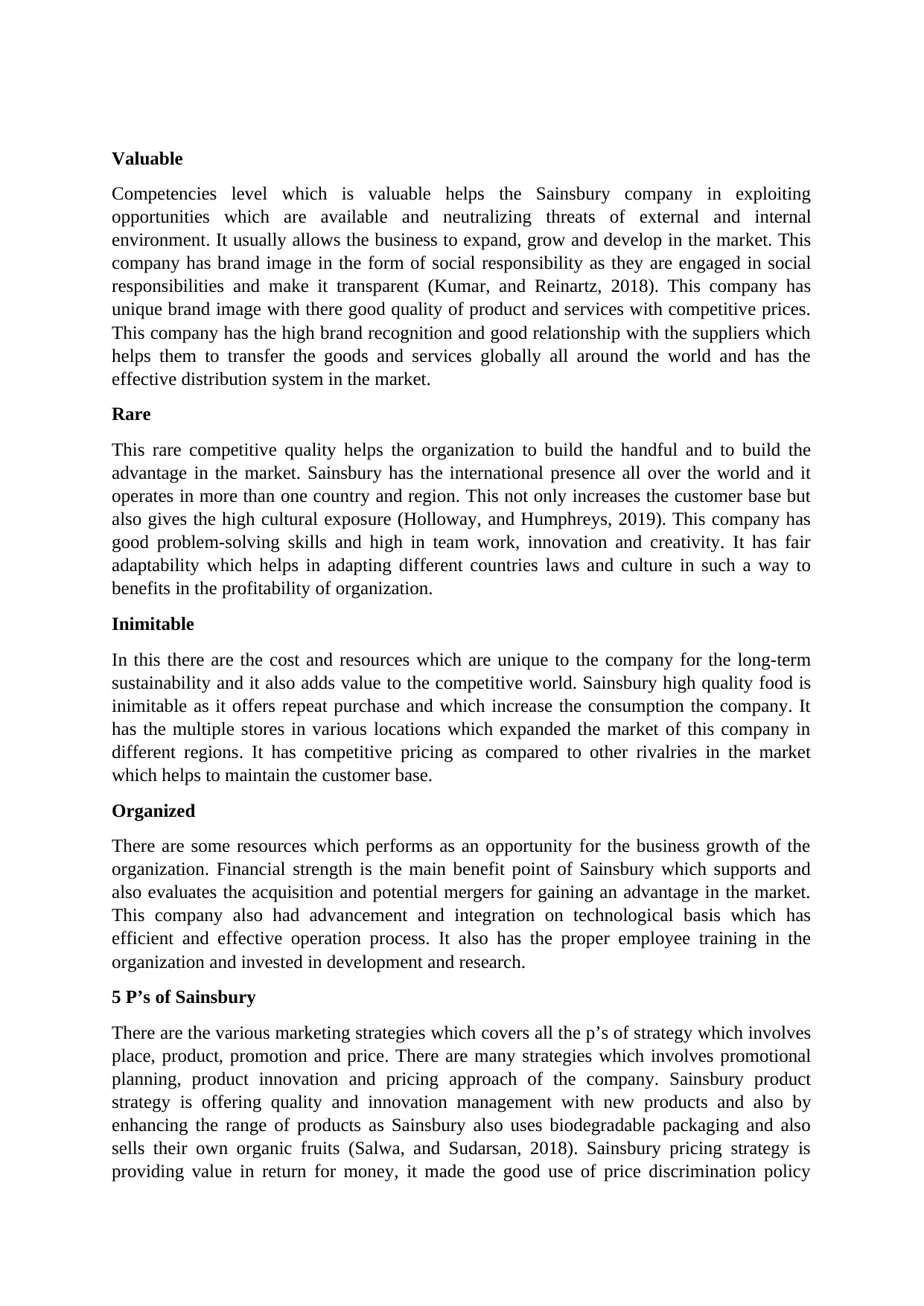
Valuable
Competencies level which is valuable helps the Sainsbury company in exploiting
opportunities which are available and neutralizing threats of external and internal
environment. It usually allows the business to expand, grow and develop in the market. This
company has brand image in the form of social responsibility as they are engaged in social
responsibilities and make it transparent (Kumar, and Reinartz, 2018). This company has
unique brand image with there good quality of product and services with competitive prices.
This company has the high brand recognition and good relationship with the suppliers which
helps them to transfer the goods and services globally all around the world and has the
effective distribution system in the market.
Rare
This rare competitive quality helps the organization to build the handful and to build the
advantage in the market. Sainsbury has the international presence all over the world and it
operates in more than one country and region. This not only increases the customer base but
also gives the high cultural exposure (Holloway, and Humphreys, 2019). This company has
good problem-solving skills and high in team work, innovation and creativity. It has fair
adaptability which helps in adapting different countries laws and culture in such a way to
benefits in the profitability of organization.
Inimitable
In this there are the cost and resources which are unique to the company for the long-term
sustainability and it also adds value to the competitive world. Sainsbury high quality food is
inimitable as it offers repeat purchase and which increase the consumption the company. It
has the multiple stores in various locations which expanded the market of this company in
different regions. It has competitive pricing as compared to other rivalries in the market
which helps to maintain the customer base.
Organized
There are some resources which performs as an opportunity for the business growth of the
organization. Financial strength is the main benefit point of Sainsbury which supports and
also evaluates the acquisition and potential mergers for gaining an advantage in the market.
This company also had advancement and integration on technological basis which has
efficient and effective operation process. It also has the proper employee training in the
organization and invested in development and research.
5 P’s of Sainsbury
There are the various marketing strategies which covers all the p’s of strategy which involves
place, product, promotion and price. There are many strategies which involves promotional
planning, product innovation and pricing approach of the company. Sainsbury product
strategy is offering quality and innovation management with new products and also by
enhancing the range of products as Sainsbury also uses biodegradable packaging and also
sells their own organic fruits (Salwa, and Sudarsan, 2018). Sainsbury pricing strategy is
providing value in return for money, it made the good use of price discrimination policy
Competencies level which is valuable helps the Sainsbury company in exploiting
opportunities which are available and neutralizing threats of external and internal
environment. It usually allows the business to expand, grow and develop in the market. This
company has brand image in the form of social responsibility as they are engaged in social
responsibilities and make it transparent (Kumar, and Reinartz, 2018). This company has
unique brand image with there good quality of product and services with competitive prices.
This company has the high brand recognition and good relationship with the suppliers which
helps them to transfer the goods and services globally all around the world and has the
effective distribution system in the market.
Rare
This rare competitive quality helps the organization to build the handful and to build the
advantage in the market. Sainsbury has the international presence all over the world and it
operates in more than one country and region. This not only increases the customer base but
also gives the high cultural exposure (Holloway, and Humphreys, 2019). This company has
good problem-solving skills and high in team work, innovation and creativity. It has fair
adaptability which helps in adapting different countries laws and culture in such a way to
benefits in the profitability of organization.
Inimitable
In this there are the cost and resources which are unique to the company for the long-term
sustainability and it also adds value to the competitive world. Sainsbury high quality food is
inimitable as it offers repeat purchase and which increase the consumption the company. It
has the multiple stores in various locations which expanded the market of this company in
different regions. It has competitive pricing as compared to other rivalries in the market
which helps to maintain the customer base.
Organized
There are some resources which performs as an opportunity for the business growth of the
organization. Financial strength is the main benefit point of Sainsbury which supports and
also evaluates the acquisition and potential mergers for gaining an advantage in the market.
This company also had advancement and integration on technological basis which has
efficient and effective operation process. It also has the proper employee training in the
organization and invested in development and research.
5 P’s of Sainsbury
There are the various marketing strategies which covers all the p’s of strategy which involves
place, product, promotion and price. There are many strategies which involves promotional
planning, product innovation and pricing approach of the company. Sainsbury product
strategy is offering quality and innovation management with new products and also by
enhancing the range of products as Sainsbury also uses biodegradable packaging and also
sells their own organic fruits (Salwa, and Sudarsan, 2018). Sainsbury pricing strategy is
providing value in return for money, it made the good use of price discrimination policy
⊘ This is a preview!⊘
Do you want full access?
Subscribe today to unlock all pages.

Trusted by 1+ million students worldwide

which provide food quality with low price. Sainsbury distribution and place strategy has
expanded in various region and countries as it has more then 500 chains of supermarket and
convenience stores more than 700 which the operating time of 24 * 7. Sainsbury promotion
and advertising strategies used by Sainsbury are the various innovative kind of packaging
techniques and various methods to increase the sales. This company also uses various
marketing strategies with using of slogans and innovative marketing techniques.
The impact and influence of change and culture.
Kurt Lewin is the model which is used for implementing the change in the organization.
Organizational change demonstrates movement of a company from current to desired state.
the reason for the same is due to the fact that result of this change is not certain and it may
have concerns related to worth of people, coping abilities and competency, because of which
people of the company are not in support of this change until and unless they have confidence
against status quo (Renuka, Das, and Reddy, 2018). Sainsbury might invest huge amount for
status quote eventually resisting change will be taking place in order to avoid future
uncertainty of the company. Sainsbury’s change management is known as process of
renewing organizational capabilities, direction and structure which serves customer’s
requirements and needs in order of external and internal environment.
Handy has influenced culture management for the transition includes power, task culture,
person culture and the role culture. Power in Sainsbury is in the hand of few people and they
are the ones who are authorized for decision making and enjoys some special privileges.
These authorized people then assign the responsibilities to other employees and those
employees have to follow the instructions of superiors (Dinh, Karmakar,and Kamruzzaman,
2020). These factors can lead to biasness by managers. In Sainsbury teams are designed to
solve critical hassles and achieve targets which means it follows task culture. Teams are
formed in a way keeping in mind the common interests and their specializations. This culture
motivates each team member to equally contribute and achieve tasks in innovative ways.
Sainsbury follows person culture which means that individuals keep themselves over
organization and in such a culture organization suffers.
TQM is the management approach for the long-term success in the form of customer
satisfaction. In total quality management all the members are involved to improve process,
product and services. Sainsbury are customer focused with new innovative products and
packaging (Martinsuo,and Hoverfält, 2018). Sainsbury also involves each employee to the
decision-making process and in environmental part. Sainsbury is the integrated system with
special structured department with understanding of principles and mission of the
organization.
Stakeholders are the one who stakes the project and plays a important role in an organization.
Stakeholders are specifically segmented in four groups which are sponsors, project team,
reference group and users (Suppatvech, Godsell, and Day, 2019). Stakeholder mapping is
known as the collaborative process which includes discussion, research and debate. This
mapping steps involves identifying, analyzing, mapping and prioritizing.
Strategic planning
expanded in various region and countries as it has more then 500 chains of supermarket and
convenience stores more than 700 which the operating time of 24 * 7. Sainsbury promotion
and advertising strategies used by Sainsbury are the various innovative kind of packaging
techniques and various methods to increase the sales. This company also uses various
marketing strategies with using of slogans and innovative marketing techniques.
The impact and influence of change and culture.
Kurt Lewin is the model which is used for implementing the change in the organization.
Organizational change demonstrates movement of a company from current to desired state.
the reason for the same is due to the fact that result of this change is not certain and it may
have concerns related to worth of people, coping abilities and competency, because of which
people of the company are not in support of this change until and unless they have confidence
against status quo (Renuka, Das, and Reddy, 2018). Sainsbury might invest huge amount for
status quote eventually resisting change will be taking place in order to avoid future
uncertainty of the company. Sainsbury’s change management is known as process of
renewing organizational capabilities, direction and structure which serves customer’s
requirements and needs in order of external and internal environment.
Handy has influenced culture management for the transition includes power, task culture,
person culture and the role culture. Power in Sainsbury is in the hand of few people and they
are the ones who are authorized for decision making and enjoys some special privileges.
These authorized people then assign the responsibilities to other employees and those
employees have to follow the instructions of superiors (Dinh, Karmakar,and Kamruzzaman,
2020). These factors can lead to biasness by managers. In Sainsbury teams are designed to
solve critical hassles and achieve targets which means it follows task culture. Teams are
formed in a way keeping in mind the common interests and their specializations. This culture
motivates each team member to equally contribute and achieve tasks in innovative ways.
Sainsbury follows person culture which means that individuals keep themselves over
organization and in such a culture organization suffers.
TQM is the management approach for the long-term success in the form of customer
satisfaction. In total quality management all the members are involved to improve process,
product and services. Sainsbury are customer focused with new innovative products and
packaging (Martinsuo,and Hoverfält, 2018). Sainsbury also involves each employee to the
decision-making process and in environmental part. Sainsbury is the integrated system with
special structured department with understanding of principles and mission of the
organization.
Stakeholders are the one who stakes the project and plays a important role in an organization.
Stakeholders are specifically segmented in four groups which are sponsors, project team,
reference group and users (Suppatvech, Godsell, and Day, 2019). Stakeholder mapping is
known as the collaborative process which includes discussion, research and debate. This
mapping steps involves identifying, analyzing, mapping and prioritizing.
Strategic planning
Paraphrase This Document
Need a fresh take? Get an instant paraphrase of this document with our AI Paraphraser
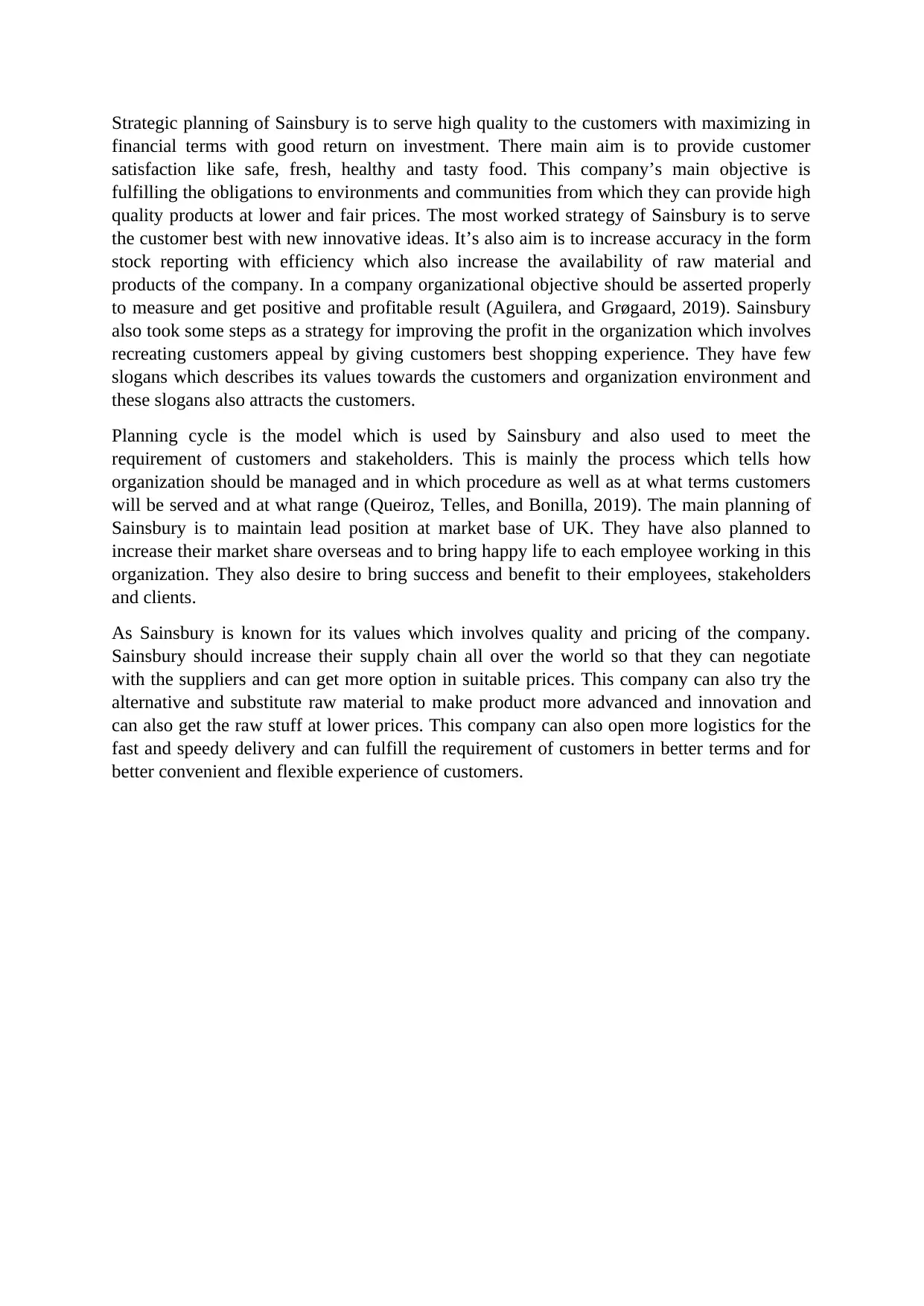
Strategic planning of Sainsbury is to serve high quality to the customers with maximizing in
financial terms with good return on investment. There main aim is to provide customer
satisfaction like safe, fresh, healthy and tasty food. This company’s main objective is
fulfilling the obligations to environments and communities from which they can provide high
quality products at lower and fair prices. The most worked strategy of Sainsbury is to serve
the customer best with new innovative ideas. It’s also aim is to increase accuracy in the form
stock reporting with efficiency which also increase the availability of raw material and
products of the company. In a company organizational objective should be asserted properly
to measure and get positive and profitable result (Aguilera, and Grøgaard, 2019). Sainsbury
also took some steps as a strategy for improving the profit in the organization which involves
recreating customers appeal by giving customers best shopping experience. They have few
slogans which describes its values towards the customers and organization environment and
these slogans also attracts the customers.
Planning cycle is the model which is used by Sainsbury and also used to meet the
requirement of customers and stakeholders. This is mainly the process which tells how
organization should be managed and in which procedure as well as at what terms customers
will be served and at what range (Queiroz, Telles, and Bonilla, 2019). The main planning of
Sainsbury is to maintain lead position at market base of UK. They have also planned to
increase their market share overseas and to bring happy life to each employee working in this
organization. They also desire to bring success and benefit to their employees, stakeholders
and clients.
As Sainsbury is known for its values which involves quality and pricing of the company.
Sainsbury should increase their supply chain all over the world so that they can negotiate
with the suppliers and can get more option in suitable prices. This company can also try the
alternative and substitute raw material to make product more advanced and innovation and
can also get the raw stuff at lower prices. This company can also open more logistics for the
fast and speedy delivery and can fulfill the requirement of customers in better terms and for
better convenient and flexible experience of customers.
financial terms with good return on investment. There main aim is to provide customer
satisfaction like safe, fresh, healthy and tasty food. This company’s main objective is
fulfilling the obligations to environments and communities from which they can provide high
quality products at lower and fair prices. The most worked strategy of Sainsbury is to serve
the customer best with new innovative ideas. It’s also aim is to increase accuracy in the form
stock reporting with efficiency which also increase the availability of raw material and
products of the company. In a company organizational objective should be asserted properly
to measure and get positive and profitable result (Aguilera, and Grøgaard, 2019). Sainsbury
also took some steps as a strategy for improving the profit in the organization which involves
recreating customers appeal by giving customers best shopping experience. They have few
slogans which describes its values towards the customers and organization environment and
these slogans also attracts the customers.
Planning cycle is the model which is used by Sainsbury and also used to meet the
requirement of customers and stakeholders. This is mainly the process which tells how
organization should be managed and in which procedure as well as at what terms customers
will be served and at what range (Queiroz, Telles, and Bonilla, 2019). The main planning of
Sainsbury is to maintain lead position at market base of UK. They have also planned to
increase their market share overseas and to bring happy life to each employee working in this
organization. They also desire to bring success and benefit to their employees, stakeholders
and clients.
As Sainsbury is known for its values which involves quality and pricing of the company.
Sainsbury should increase their supply chain all over the world so that they can negotiate
with the suppliers and can get more option in suitable prices. This company can also try the
alternative and substitute raw material to make product more advanced and innovation and
can also get the raw stuff at lower prices. This company can also open more logistics for the
fast and speedy delivery and can fulfill the requirement of customers in better terms and for
better convenient and flexible experience of customers.
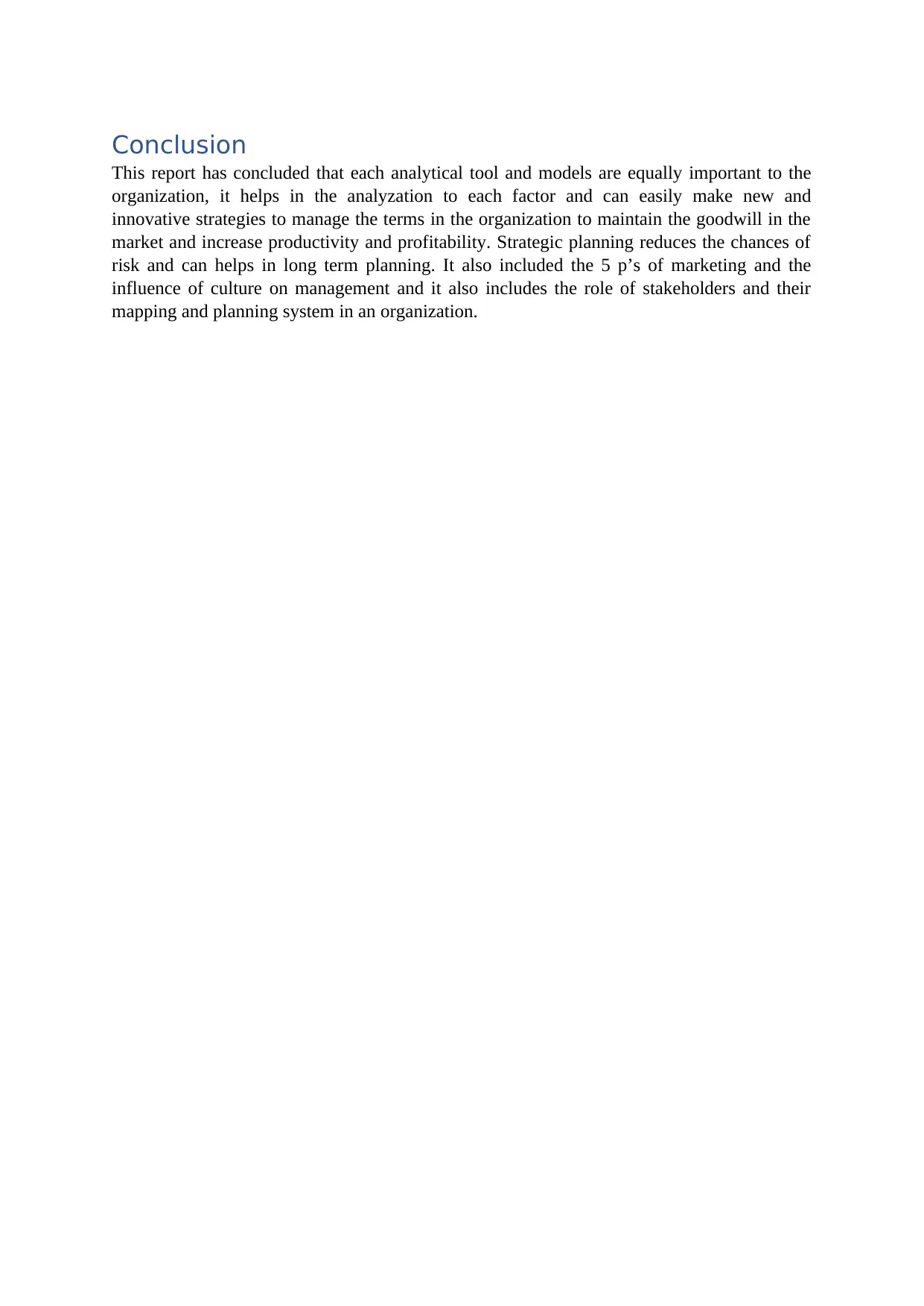
Conclusion
This report has concluded that each analytical tool and models are equally important to the
organization, it helps in the analyzation to each factor and can easily make new and
innovative strategies to manage the terms in the organization to maintain the goodwill in the
market and increase productivity and profitability. Strategic planning reduces the chances of
risk and can helps in long term planning. It also included the 5 p’s of marketing and the
influence of culture on management and it also includes the role of stakeholders and their
mapping and planning system in an organization.
This report has concluded that each analytical tool and models are equally important to the
organization, it helps in the analyzation to each factor and can easily make new and
innovative strategies to manage the terms in the organization to maintain the goodwill in the
market and increase productivity and profitability. Strategic planning reduces the chances of
risk and can helps in long term planning. It also included the 5 p’s of marketing and the
influence of culture on management and it also includes the role of stakeholders and their
mapping and planning system in an organization.
⊘ This is a preview!⊘
Do you want full access?
Subscribe today to unlock all pages.

Trusted by 1+ million students worldwide
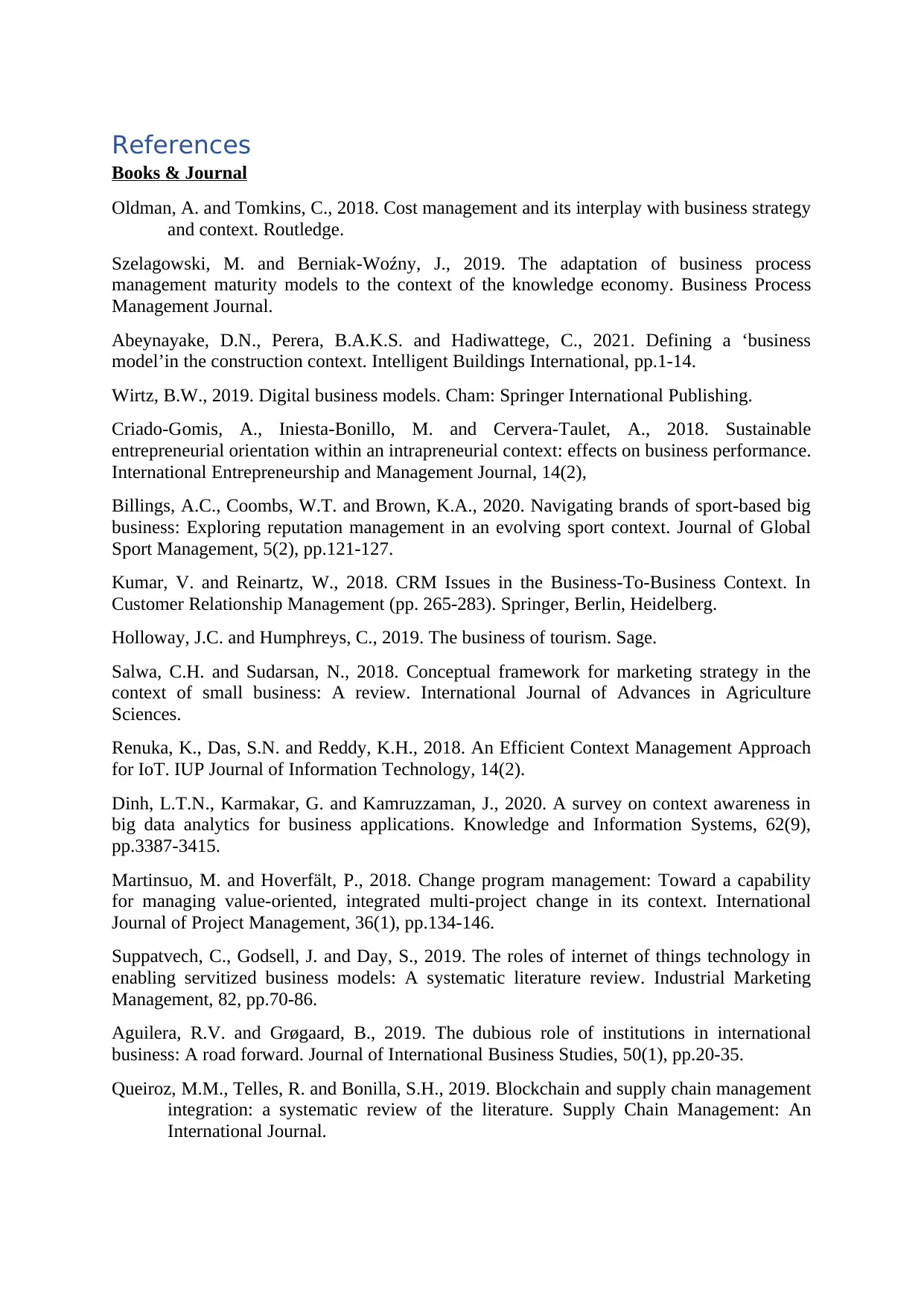
References
Books & Journal
Oldman, A. and Tomkins, C., 2018. Cost management and its interplay with business strategy
and context. Routledge.
Szelagowski, M. and Berniak-Woźny, J., 2019. The adaptation of business process
management maturity models to the context of the knowledge economy. Business Process
Management Journal.
Abeynayake, D.N., Perera, B.A.K.S. and Hadiwattege, C., 2021. Defining a ‘business
model’in the construction context. Intelligent Buildings International, pp.1-14.
Wirtz, B.W., 2019. Digital business models. Cham: Springer International Publishing.
Criado-Gomis, A., Iniesta-Bonillo, M. and Cervera-Taulet, A., 2018. Sustainable
entrepreneurial orientation within an intrapreneurial context: effects on business performance.
International Entrepreneurship and Management Journal, 14(2),
Billings, A.C., Coombs, W.T. and Brown, K.A., 2020. Navigating brands of sport-based big
business: Exploring reputation management in an evolving sport context. Journal of Global
Sport Management, 5(2), pp.121-127.
Kumar, V. and Reinartz, W., 2018. CRM Issues in the Business-To-Business Context. In
Customer Relationship Management (pp. 265-283). Springer, Berlin, Heidelberg.
Holloway, J.C. and Humphreys, C., 2019. The business of tourism. Sage.
Salwa, C.H. and Sudarsan, N., 2018. Conceptual framework for marketing strategy in the
context of small business: A review. International Journal of Advances in Agriculture
Sciences.
Renuka, K., Das, S.N. and Reddy, K.H., 2018. An Efficient Context Management Approach
for IoT. IUP Journal of Information Technology, 14(2).
Dinh, L.T.N., Karmakar, G. and Kamruzzaman, J., 2020. A survey on context awareness in
big data analytics for business applications. Knowledge and Information Systems, 62(9),
pp.3387-3415.
Martinsuo, M. and Hoverfält, P., 2018. Change program management: Toward a capability
for managing value-oriented, integrated multi-project change in its context. International
Journal of Project Management, 36(1), pp.134-146.
Suppatvech, C., Godsell, J. and Day, S., 2019. The roles of internet of things technology in
enabling servitized business models: A systematic literature review. Industrial Marketing
Management, 82, pp.70-86.
Aguilera, R.V. and Grøgaard, B., 2019. The dubious role of institutions in international
business: A road forward. Journal of International Business Studies, 50(1), pp.20-35.
Queiroz, M.M., Telles, R. and Bonilla, S.H., 2019. Blockchain and supply chain management
integration: a systematic review of the literature. Supply Chain Management: An
International Journal.
Books & Journal
Oldman, A. and Tomkins, C., 2018. Cost management and its interplay with business strategy
and context. Routledge.
Szelagowski, M. and Berniak-Woźny, J., 2019. The adaptation of business process
management maturity models to the context of the knowledge economy. Business Process
Management Journal.
Abeynayake, D.N., Perera, B.A.K.S. and Hadiwattege, C., 2021. Defining a ‘business
model’in the construction context. Intelligent Buildings International, pp.1-14.
Wirtz, B.W., 2019. Digital business models. Cham: Springer International Publishing.
Criado-Gomis, A., Iniesta-Bonillo, M. and Cervera-Taulet, A., 2018. Sustainable
entrepreneurial orientation within an intrapreneurial context: effects on business performance.
International Entrepreneurship and Management Journal, 14(2),
Billings, A.C., Coombs, W.T. and Brown, K.A., 2020. Navigating brands of sport-based big
business: Exploring reputation management in an evolving sport context. Journal of Global
Sport Management, 5(2), pp.121-127.
Kumar, V. and Reinartz, W., 2018. CRM Issues in the Business-To-Business Context. In
Customer Relationship Management (pp. 265-283). Springer, Berlin, Heidelberg.
Holloway, J.C. and Humphreys, C., 2019. The business of tourism. Sage.
Salwa, C.H. and Sudarsan, N., 2018. Conceptual framework for marketing strategy in the
context of small business: A review. International Journal of Advances in Agriculture
Sciences.
Renuka, K., Das, S.N. and Reddy, K.H., 2018. An Efficient Context Management Approach
for IoT. IUP Journal of Information Technology, 14(2).
Dinh, L.T.N., Karmakar, G. and Kamruzzaman, J., 2020. A survey on context awareness in
big data analytics for business applications. Knowledge and Information Systems, 62(9),
pp.3387-3415.
Martinsuo, M. and Hoverfält, P., 2018. Change program management: Toward a capability
for managing value-oriented, integrated multi-project change in its context. International
Journal of Project Management, 36(1), pp.134-146.
Suppatvech, C., Godsell, J. and Day, S., 2019. The roles of internet of things technology in
enabling servitized business models: A systematic literature review. Industrial Marketing
Management, 82, pp.70-86.
Aguilera, R.V. and Grøgaard, B., 2019. The dubious role of institutions in international
business: A road forward. Journal of International Business Studies, 50(1), pp.20-35.
Queiroz, M.M., Telles, R. and Bonilla, S.H., 2019. Blockchain and supply chain management
integration: a systematic review of the literature. Supply Chain Management: An
International Journal.
1 out of 10